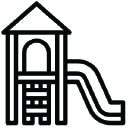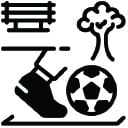Treehouse Village is located on a 16-acre property along the Centennial Trail, centrally located in Bridgewater, Nova Scotia. Every home includes a share in our outdoor space which is collectively owned and managed by the community.
Our outdoor space follows the cohousing principle to design for low-stakes interaction with your neighbours as you go about your daily activities. Each front door opens to the central courtyard (Common Green), which flows as the main artery of our community, connecting each one of us to the heart (Common House) and to each other. The courtyard offers convenient areas for neighbours to meet and interact, while also serving the functional and social needs of the community in an aesthetic and environmentally responsible way. In the courtyard and beyond, there are rain gardens and bioswales to manage all the stormwater onsite, space for growing food, and 11 acres of undeveloped forested land for trails, walking a dog, or foraging for edibles.

Outdoor Features
- Rain gardens and bioswales
- Garden space for native and edible plants
- Common House patio
- Playground
- Indoor and outdoor vehicle parking
- Bike parking
- Electric vehicle charging stations
- Direct access to the Centennial Trail
Close to Amenities

Daycare

Elementary School

Junior High School

Restaurants and Retail

Recreation

Town Bus Service
